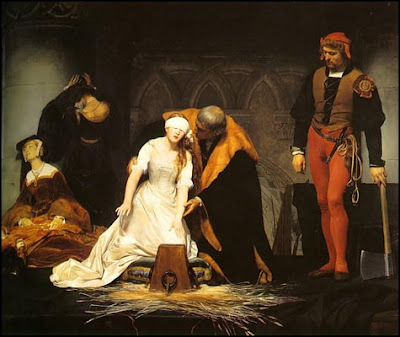February 12
 Lady Jane Grey, the so-called “Nine Day Queen,” lost her head at the Tower of London 453 years ago today. Grey, a devout worshipper in the Protestant Church of England, was installed on the throne following the death of Edward VI; to her supporters, her chief qualification was that she was not Mary Tudor, her own cousin. Tudor, one of the daughters of the former King Henry VIII, was a committed Catholic, and her faith brought great anxiety to those who feared the return of the English crown to influence of the popish devils. Through a complex series of machinations devised almost entirely by her father-in-law, John Dudley, Duke of Northumberland, Jane Grey was announced as the successor to Edward VI following his July 1553 death. Unfortunately for the new Queen, popular support for Mary -- her Catholicism notwithstanding -- led quickly to Grey's replacement barely a week after her reign began.
Lady Jane Grey, the so-called “Nine Day Queen,” lost her head at the Tower of London 453 years ago today. Grey, a devout worshipper in the Protestant Church of England, was installed on the throne following the death of Edward VI; to her supporters, her chief qualification was that she was not Mary Tudor, her own cousin. Tudor, one of the daughters of the former King Henry VIII, was a committed Catholic, and her faith brought great anxiety to those who feared the return of the English crown to influence of the popish devils. Through a complex series of machinations devised almost entirely by her father-in-law, John Dudley, Duke of Northumberland, Jane Grey was announced as the successor to Edward VI following his July 1553 death. Unfortunately for the new Queen, popular support for Mary -- her Catholicism notwithstanding -- led quickly to Grey's replacement barely a week after her reign began.Imprisoned in the Tower with her husband, Guildford Dudley, Lady Jane was convicted and sentenced to die for treason in November 1553. No one, however, expected Queen Mary to allow the sentence to proceed. Indeed, Jane Grey would quite probably have enjoyed a long -- and eventually free -- life had not her father, the Duke of Suffolk, attempted a revolt against the new Queen Mary in January 1554. Somewhat reluctantly, the Queen accepted her advisers' counsel that so long as Jane Grey remained alive, she would serve as a beacon for zealous, rebellious protestants. Grey -- who had nothing to do with her father's plot -- was executed on 12 February 1554, an hour after her husband was similarly beheaded. After she was escorted to the scaffold and blindfolded, Jane Grey delivered her last address to the small audience:
Before God and the face of you, good Christian people, this day I pray you all, to bear me witness that I die a true Christian woman, and that I look to be saved by none other means, but only by the mercy of God, in the merits of the blood of his only son, Jesus Christ. And I confess, when I did know the word of God, I neglected the same, loved myself and the world, and thereto the plague or punishment is happily and worthily happened unto me for my sins. And yet, I thank God of His goodness that he hath thus given me a time and respite to repent. And now good people, while I am alive, I pray you to assist me with your prayers.'=After her prayer, Jane Grey was blindfolded and made to kneel. Unable to find the block of wood where she was to rest her head for the last time, the young girl began to panic. After a bystander helped the condemned to the right spot, her executioner finished the job. Jane Grey was 16 years old.
Labels: death penalty